Oldsmobile Aurora 1997 s Service Manual
Manufacturer: OLDSMOBILE, Model Year: 1997, Model line: Aurora, Model: Oldsmobile Aurora 1997Pages: 404, PDF Size: 20.75 MB
Page 41 of 404

Children
Everyone in a vehicle needs protection! That includes
infants
and all children smaller than adult size. In fact,
the law in every state
in the United States and in every
Canadian province says children up to some age must be
restrained
while in a vehicle.
Smaller Children and Babies
Smaller children and babies should always be
restrained in
a child or infant restraint. The
instructions for the restraint will
say whether it is
the right type and size for your child.
A very
young child’s hip bones are
so small that a
regular belt might not stay low on the hips,
as it
should. Instead, the belt will likely be over the
child’s abdomen. In
a crash, the belt would apply
force right on the child’s abdomen, which could
cause serious or fatal injuries.
So, be sure that
any child small enough for one is always properly
1 restrained in a child or infant restraint.
1-33
Page 42 of 404
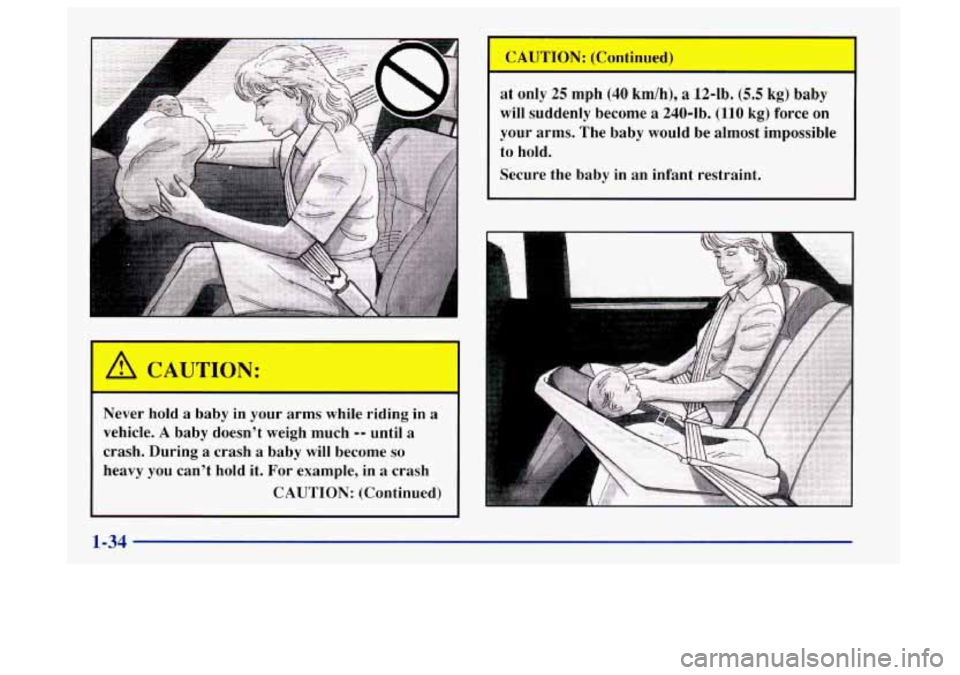
L?!, CAUTION: I I
Never hold a baby in your arms while riding in a
vehicle. A baby doesn’t weigh much -- until a
crash. During a crash a baby will become so
heavy you can’t hold it. For example, in a crash
CAUTION: (Continued) at
only
25 mph (40 km/h), a 12-1b. (5.5 kg) baby
will suddenly become
a 240-lb. (110 kg) force on
your arms. The baby would be almost impossible
to hold.
Secure the baby in an infant restraint.
Page 43 of 404
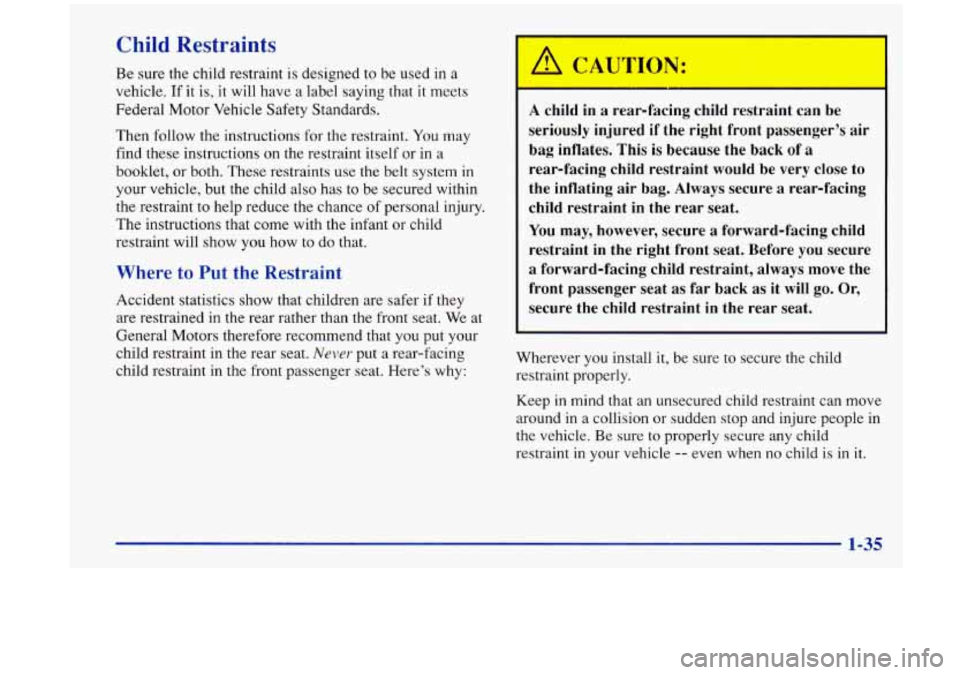
Child Restraints
Be sure the child restraint is designed to be used in a
vehicle. If it is, it will have a label saying that it meets
Federal Motor Vehicle Safety Standards.
Then follow
the instructions for the restraint. You may
find these instructions on the restraint itself or in
a
booklet, or both. These restraints use the belt system in
your vehicle, but the child also has to be secured within
the restraint
to help reduce the chance of personal injury.
The instructions that come with the infant or child
restraint will show you how to do that.
Where to Put the Restraint
Accident statistics show that children are safer if they
are restrained in the rear rather than the front seat. We at
General Motors therefore recommend that you put your
child restraint in the rear seat.
Never put a rear-facing
child restraint in the front passenger seat. Here’s why:
’ CAUTION: *-
A child in a rear-facing child restraint can be
seriously injured if the right front passenger’s air
bag inflates. This is because the back
of a
rear-facing child restraint would be very close to
the inflating air bag. Always secure a rear-facing
child restraint in the rear seat.
You may, however, secure a forward-facing child
restraint in the right front seat. Before
you secure
a forward-facing child restraint, always move the
front passenger seat
as far back as it will go. Or,
secure the child restraint
in the rear seat.
Wherever you install it, be sure to secure the child
restraint properly.
Keep
in mind that an unsecured child restraint can move
around in a collision or sudden stop and injure people in
the vehicle. Be sure to properly secure any child
restraint in your vehicle
-- even when no child is in it.
Page 44 of 404
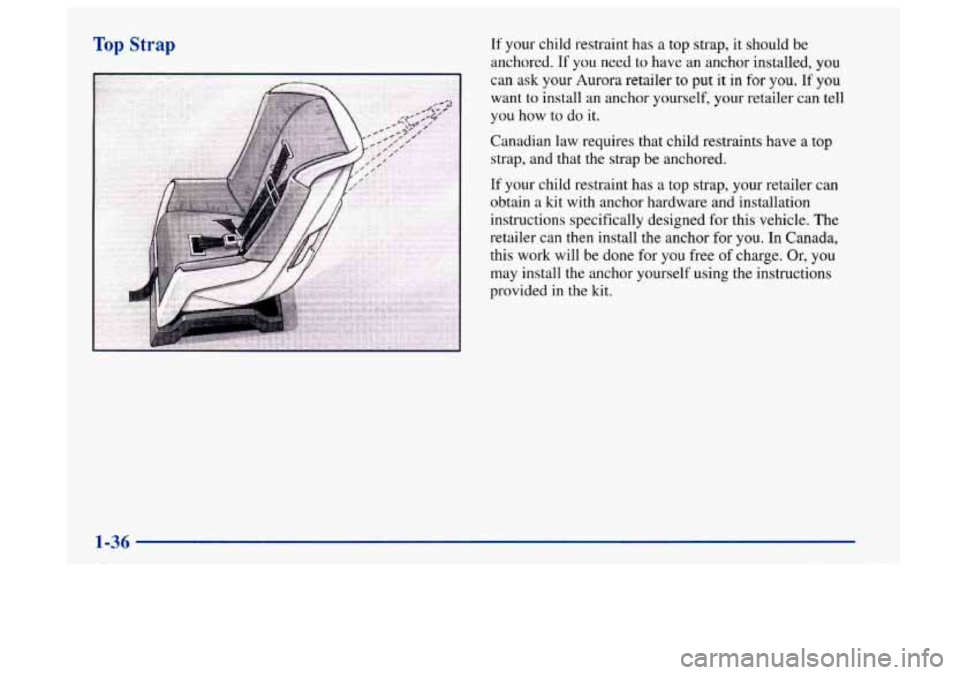
Top Strap If your child restraint has a top strap, it should be
anchored.
If you need to have an anchor installed, you
can ask your Aurora retailer
to put it in for you. If you
want to install an anchor yourself, your retailer can tell
you how to do it.
Canadian law requires that child restraints have a top
strap, and that the strap be anchored.
If your child restraint has a top strap, your retailer can
obtain a kit with anchor hardware and installation
instructions specifically designed for this vehicle. The
retailer can then install the anchor for you. In Canada,
this work will be done for
you free of charge. Or, you
may install the anchor yourself using the instructions
provided in the kit.
1-36
Page 45 of 404

Securing a Child Restraint in a Rear
Outside Seat Position
You’ll be using the lap-shoulder belt. See the earlier part
about the top strap
if the child restraint has one.
1. Put the restraint on the seat. Follow the instructions
for the child restraint.
2. Secure the child in the child restraint as the
instructions say.
3. Pick up the latch plate, and run the lap and shoulder
portions of the vehicle’s safety belt through or
around the restraint. The child restraint instructions
will show you how.
4. Tilt the latch plate to adjust the belt if needed.
If the shoulder belt goes in front of the child’s face or
neck, put it behind the child restraint.
1-37
Page 46 of 404
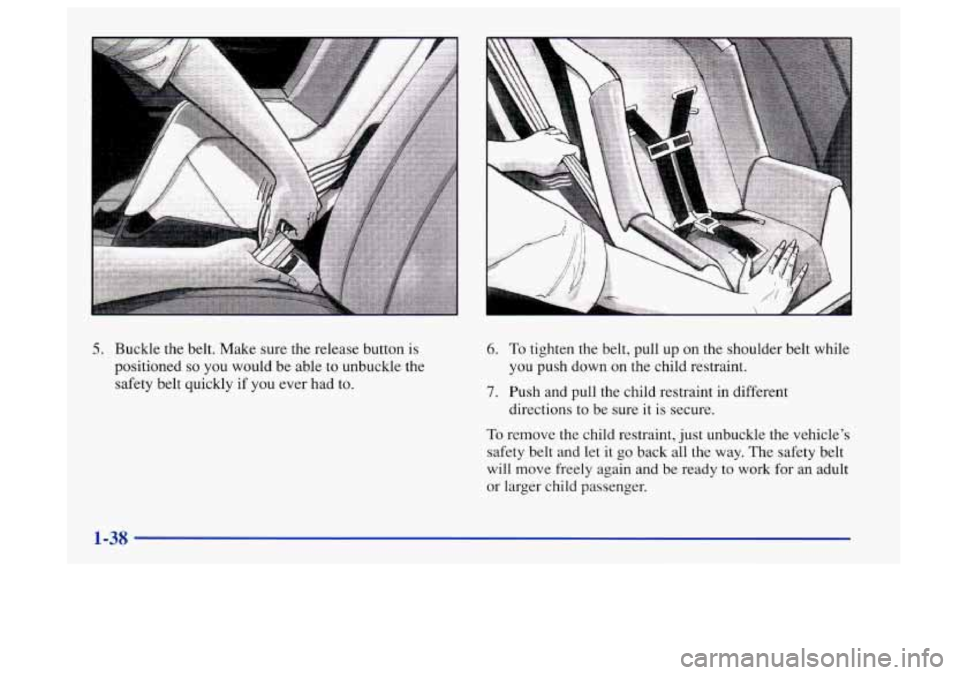
5. Buckle the belt. Make sure the release button is
positioned
so you would be able to unbuckle the
safety belt quickly if you ever had to.
6. To tighten the belt, pull up on the shoulder belt while
you push down on the child restraint.
7. Push and pull the child restraint in different
directions to be sure it is secure.
To remove the child restraint, just unbuckle the vehicle's
safety belt and let
it go back all the way. The safety belt
will move freely again and be ready to work for
an adult
or larger child passenger.
1-38
Page 47 of 404

Securing a Child Restraint in the Center
Rear Seat Position
U
You’ll be using the lap belt.
See the earlier part about the top strap if the child
restraint has one.
1.
2.
3.
4.
Make the belt as long as possible by tilting the latch
plate and pulling
it along the belt.
Put the restraint on the seat. Follow the instructions
for the child restraint.
Secure the child in the child restraint as the
instructions say.
Run the vehicle’s safety belt through or around the
restraint. The child restraint instructions will show
you how.
1-39
Page 48 of 404
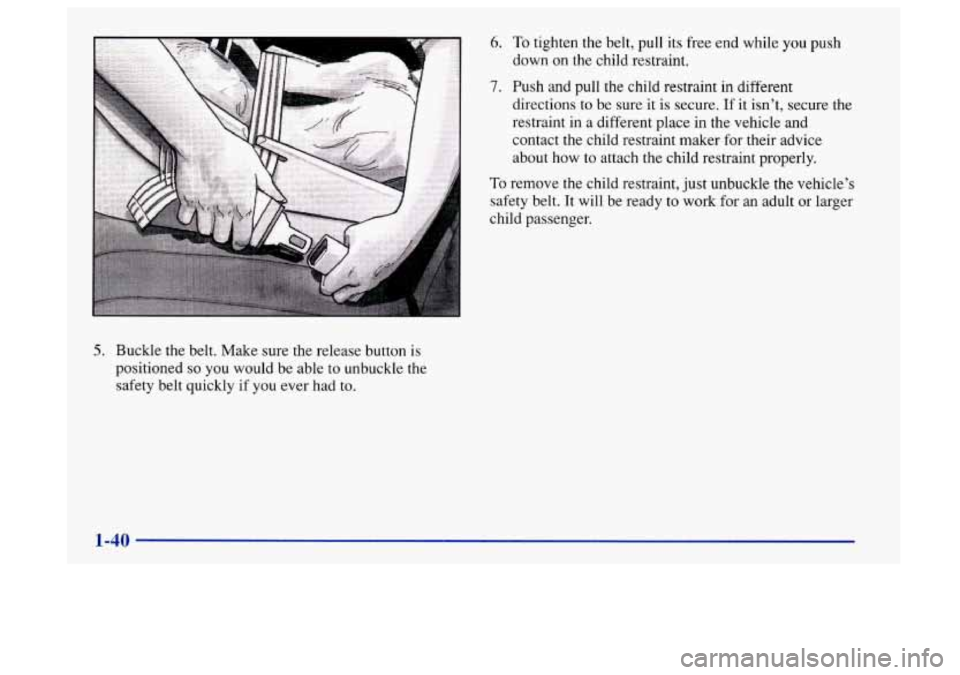
6. To tighten the belt, pull its free end while you push
down
on the child restraint.
7. Push and pull the child restraint in different
directions to be sure it is secure.
If it isn’t, secure the
restraint in a different place in the vehicle and
contact the child restraint maker for their advice
about how to attach the child restraint properly.
To remove the child restraint, just unbuckle the vehicle’s
safety belt.
It will be ready to work for an adult or larger
child passenger.
5. Buckle the belt, Make sure the release button is
positioned so you would be able to unbuckle the
safety belt quickly
if you ever had to.
1-40
Page 49 of 404
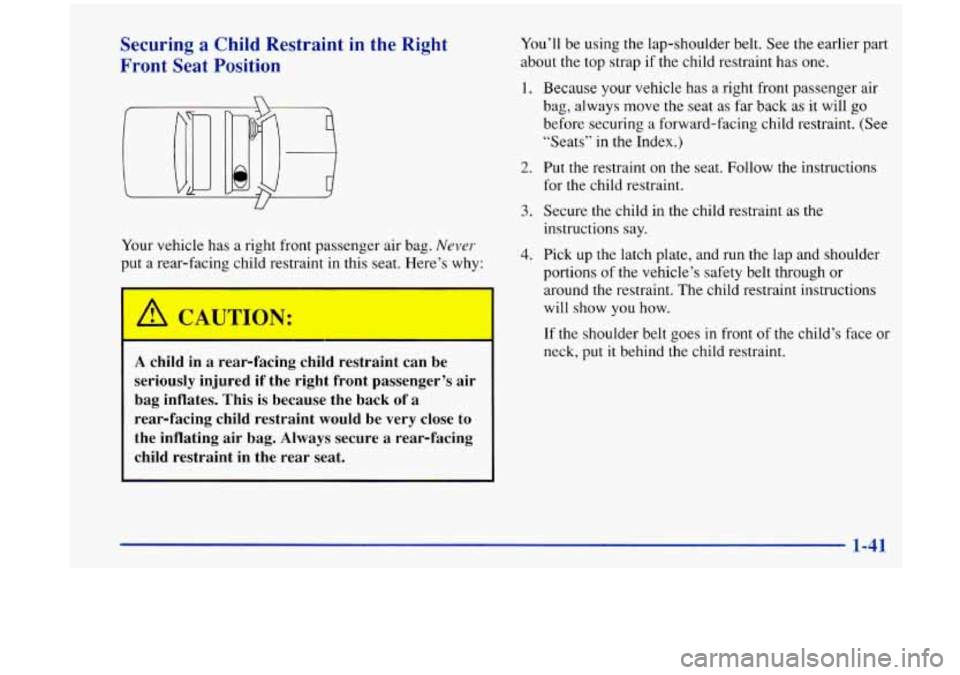
Securing a Child Restraint in the Right
Front Seat Position
Your vehicle has a right front passenger air bag. Never.
put a rear-facing child restraint in this seat. Here’s why:
I /1 CAUTIOwT:
I --
A child in a rear-facing child restraint can be
seriously injured if the right front passenger’s air
bag inflates. This
is because the back of a
rear-facing child restraint would be very close to
the inflating air bag. Always secure a rear-facing
child restraint in the rear seat.
You’ll be using the lap-shoulder belt. See the earlier part
about the top strap
if the child restraint has one.
1. Because your vehicle has a right front passenger air
bag, always move the seat as far back as it will go
before securing a forward-facing child restraint. (See
“Seats” in
the Index.)
2. Put the restraint on the seat. Follow the instructions
for the child restraint.
3. Secure the child in the child restraint as the
instructions say.
4. Pick up the latch plate, and run the lap and shoulder
portions of the vehicle’s safety belt through or
around the restraint. The child restraint instructions
will show
you how.
If the shoulder belt goes
in front of the child’s face or
neck, put it behind
the child restraint.
Page 50 of 404
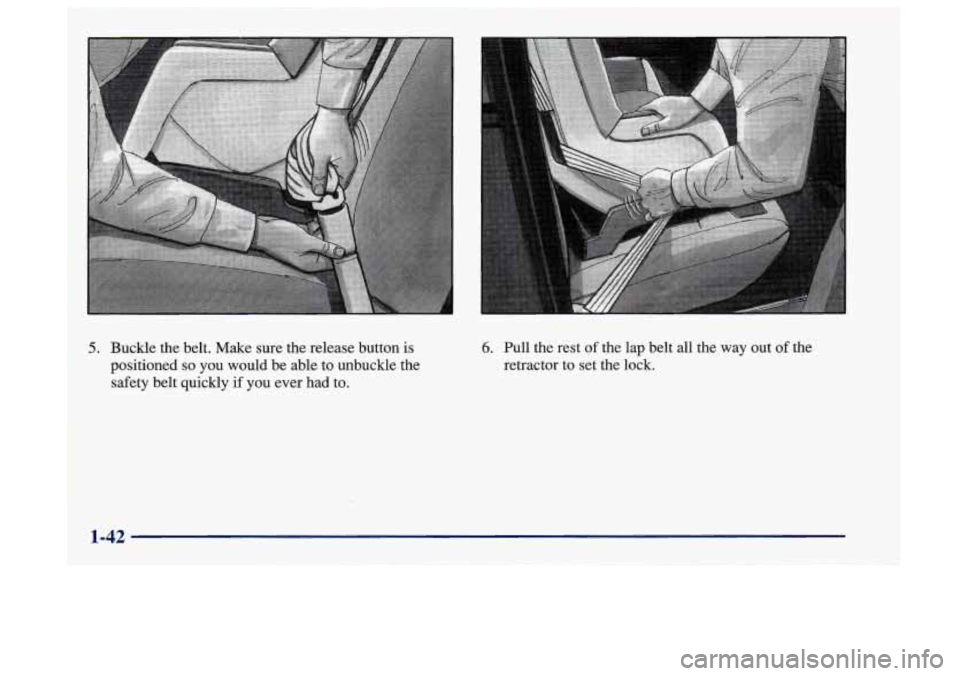
5. Buckle the belt. Make sure the release button is
positioned
so you would be able to unbuckle the
safety belt quickly if you ever had to.
6. Pull the rest of the lap belt all the way out of the
retractor to set the lock.
1-42